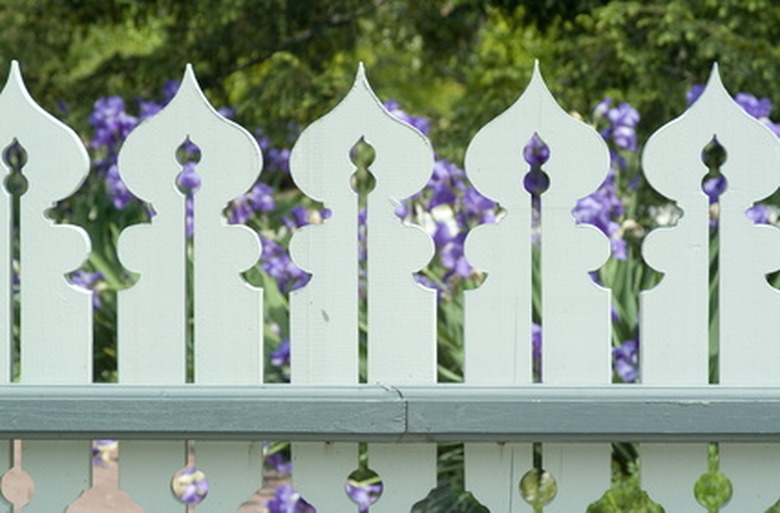Plants For Victorian Gardens
During the reign of Queen Victoria from 1837 to 1901, gardening became an English passion. The Victorian garden was a formal, ornate work of art that included statuary, manicured hedges and colorful bedding plants in geometric designs. Gravel paths and lawns provided context between the planted garden areas. Vegetables and fruits had a practical presence, usually in separate walled-in areas. Late in the 19th century, formality gave way to the "natural style" of such landscape designers as Gertrude Jekyll, who espoused the use of perennials in informal borders, according to Texas A & M University.
Vegetables
An elaborate vegetable garden could feed the Victorian household for a year with lettuces, asparagus, carrots and other produce. From sowing through harvesting and preserving, the growing season was laborious but necessary. In 2010, many gardeners strive for their own version of Victorian sustainability. As evidenced by a garden almanac circa 1800, found at Victorian Flower Garden.com, most of the vegetables we grow today were available in the 19th century, although the specific varieties are probably long gone.
- During the reign of Queen Victoria from 1837 to 1901, gardening became an English passion.
- Late in the 19th century, formality gave way to the "natural style" of such landscape designers as Gertrude Jekyll, who espoused the use of perennials in informal borders, according to Texas A & M University.
Fruits and Fruit Trees
The Victorian garden included several types of fruit trees and espaliered "wall fruits" such as apricots, peaches and plum trees that needed the extra warmth that the walls provided. Strawberries grew in beds under the trees. Greenhouses protected tender fruits such as citrus. Gardeners in the 21st century can emulate this aspect of the Victorian style by planting a few apple trees and underplanting them with berries.
Roses
Roses were the essence of the Victorian garden. Although old roses such as the damask, bourbon and china types had a place in 19th-century gardens, hybrid perpetual roses "overwhelmed" these groups in popularity due to their re-blooming traits and hardiness, according to Brent C. Dickerson, an expert on old roses cited by California State University. The Baronne Prevost rose with its pink cabbage-like blossoms and the variety Charles Lefebre in red are representative of hybrid perpetual roses bred in the Victorian era and are available from antique rose vendors.
- The Victorian garden included several types of fruit trees and espaliered "wall fruits" such as apricots, peaches and plum trees that needed the extra warmth that the walls provided.
- Although old roses such as the damask, bourbon and china types had a place in 19th-century gardens, hybrid perpetual roses "overwhelmed" these groups in popularity due to their re-blooming traits and hardiness, according to Brent C. Dickerson, an expert on old roses cited by California State University.
Shrubs and Trees
Wealthy Victorians created arboretums on their property, and showcased rhododendrons and azaleas from China, according to BBC's series "A History of British Gardening." An evergreen, white magnolia that flowered in late summer (Magnolia grandiflora) and the snowball bush (Viburnum opulus) were other Victorian favorites. Exotic trees such as the monkey puzzle tree (Auracaria) from Chile and the giant Wellingtonia (Sequoidendron), a relative of the California redwood were also widely in evidence during that era. These Victorian denizens are sometimes hard to procure today.
Perennials and Vines
Perennials came into fashion in the late 19th century as garden styles became more naturalized. Perennial borders in the 21st century harken back to the latter part of the Victorian era, according to Dr. William Welch of Texas A&M University. Border pinks (Dianthus), hollyhocks (Alcea) and larkspur enhanced late Victorian gardens as they do in modern ones. Victorians used clematis to ramble as a ground-cover or to climb arbors. Varieties like the purple jackmani are available today.
- Wealthy Victorians created arboretums on their property, and showcased rhododendrons and azaleas from China, according to BBC's series "A History of British Gardening."
- Exotic trees such as the monkey puzzle tree (Auracaria) from Chile and the giant Wellingtonia (Sequoidendron), a relative of the California redwood were also widely in evidence during that era.
Annuals
Exotic and colorful annuals were the prime elements of formal Victorian gardens, as described by Carolyn McTighe writing for Homes-Extra. Masses of geraniums, snapdragons and marigolds in gaudy juxtaposition formed geometric designs within hedge borders. Canna lilies offered an exotic flavor to the Victorian garden. With proper planning, these Victorian bedding ideas can create a similar effect in your garden.
